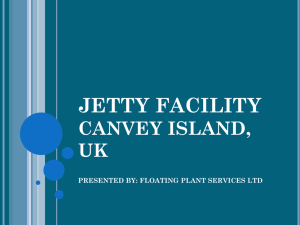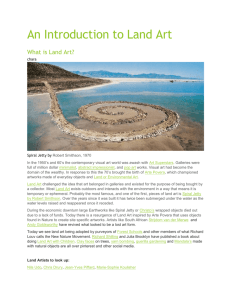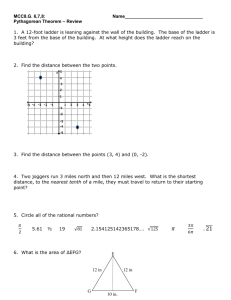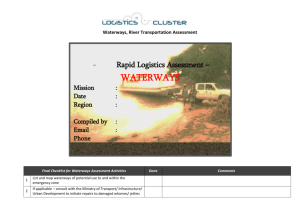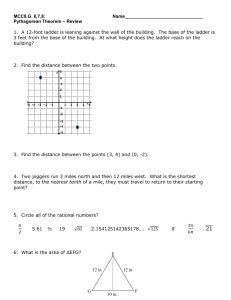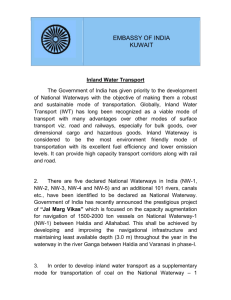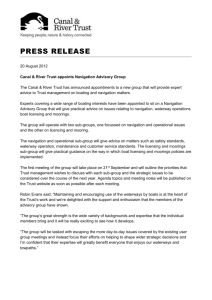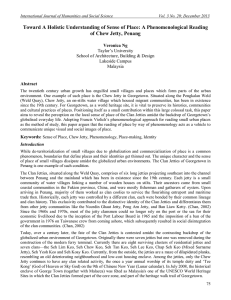Chapter 2.9 February 2015 - Wyong Shire Council Consultation Hub
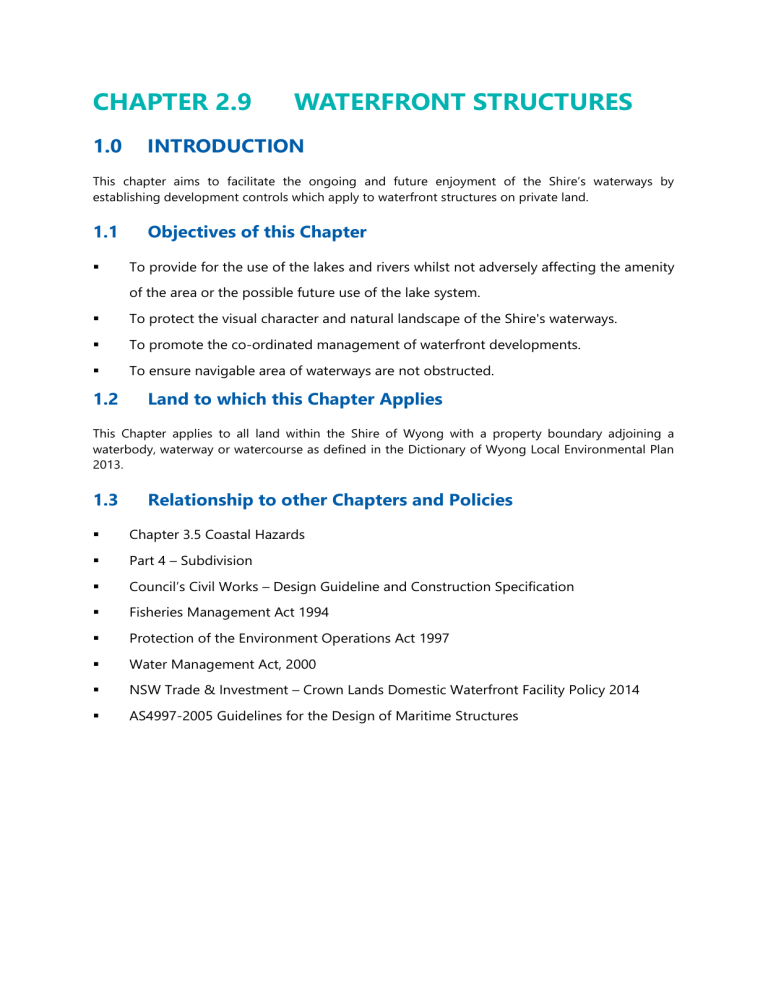
CHAPTER 2.9 WATERFRONT STRUCTURES
1.0 INTRODUCTION
This chapter aims to facilitate the ongoing and future enjoyment of the Shire’s waterways by establishing development controls which apply to waterfront structures on private land.
1.1 Objectives of this Chapter
To provide for the use of the lakes and rivers whilst not adversely affecting the amenity of the area or the possible future use of the lake system.
To protect the visual character and natural landscape of the Shire's waterways.
To promote the co-ordinated management of waterfront developments.
To ensure navigable area of waterways are not obstructed.
1.2 Land to which this Chapter Applies
This Chapter applies to all land within the Shire of Wyong with a property boundary adjoining a waterbody, waterway or watercourse as defined in the Dictionary of Wyong Local Environmental Plan
2013.
1.3 Relationship to other Chapters and Policies
Chapter 3.5 Coastal Hazards
Part 4 – Subdivision
Council’s Civil Works – Design Guideline and Construction Specification
Fisheries Management Act 1994
Protection of the Environment Operations Act 1997
Water Management Act, 2000
NSW Trade & Investment – Crown Lands Domestic Waterfront Facility Policy 2014
AS4997-2005 Guidelines for the Design of Maritime Structures
1.4 Glossary
Where a term is defined within the WLEP 2013, it is not repeated here. Additional clarifications beyond those defined terms are as follows (note that the relevant Chapter from which the term originates is in brackets for each term, unless the term appears within several Chapters):
Boat Ramp a ramp or other device or structure used or capable of use or designed or intended for use for the purpose of launching and retrieving trailable vessels
Retaining Wall also referred to as a seawall a wall that holds back earth or water from a lake or estuary.
Trailable Vessel any vessel capable of being transported overland by trailer and launched or recovered on or by the use of a ramp or sloping surface leading into a waterway.
GENERAL REQUIREMENTS
a Any material excavated from below low tide or the natural water table must be tested for potential acid-sulphate soils and, if found, treated to neutralise prior to disposal. b Compliance with the requirements of the Fisheries Management Act 1994 is required with particular regard to development affecting aquatic reserves. c Appropriate measures are to be in place to minimise and mitigate pollution of waterways. d The design of the waterfront structure shall comply with the requirements of relevant Government
Departments having an interest in the proposed works including but not limited to:- i.
The Department of Trade and Investment – Crown lands ii.
Department of Transport – Roads and Maritime Services iii.
Department of Primary Industries iv.
Mines Subsidence Board
General Objectives
To preserve natural foreshore vegetation in order to retain the visual character of the Shire’s waterways
To maintain the stability of shorelines and to protect against erosion and siltation
To minimise potential for environmental contamination and impacts.
To provide for safe and appropriate public access to waterways for public and private purposes.
To facilitate enjoyment of natural areas for recreational purposes.
2.0 BOAT RAMPS AND SLIPWAYS
Objective
To mitigate the impact of domestic boat ramps on the integrity of ecological assets.
Requirements
a The length of a boat ramp shall not exceed 5 metres when measured from the deemed high water mark into the waterway. b The width of a boat ramp shall not exceed 3 metres. c A boat ramp shall be constructed directly on the bed of the waterway. Reclamation of the bed of the waterway is not permitted under any circumstances. Minor excavation of the waterway bed, so as to produce a more even grade, is acceptable. Any excavated material is to be disposed of on private land. d A boat ramp shall be constructed flush with the natural level of the foreshore. That part of the boat ramp which is below the mean high water mark shall not project more than 150 mm above the bed of the waterway. e Boat ramps shall be constructed of concrete with a grooved non-slip surface. f A boat ramp shall enter the waterbody at the property boundary where it meets the mean high water mark. g Where retaining walls have been / are to be constructed the foreshore must be excavated such that each side of the boat ramp is reformed to a gentle batter (not greater than 1:8) so as to enable pedestrian access along the foreshore.
3.0 JETTIES
Objectives
To facilitate enjoyment of natural areas for recreation through jetty access to boats where reasonable depth of water can be obtained without dredging.
To minimise disturbance to the lakes and waterways by mitigation of adverse impacts of jetties on ecological process and marine life.
To facilitate public access to the lakes and waterways.
To minimise public liability related to private jetties.
Requirements
a Council will not grant consent to the construction of jetties from foreshores where a public reserve exists on the land above high water mark which is directly adjacent/inland from the jetty. b Council will only grant consent to the construction, extension or rebuilding of jetties which are subject to shared use and entitlement between two or more adjoining waterfront properties. c Legal access to the jetty must be available from each participating allotment. Legal access can be achieved by constructing the jetty from the common side boundary, in the case of shared use between two parties, or by the creation of a legal right of way. d A jetty shall be constructed in such a manner as to not adversely affect the natural movement of water and not cause the accumulation of weed or other material.
e A jetty should generally form a right angle with the shoreline, but may form some other angle where appropriate to the circumstances. f The length of a jetty, as measured from the deemed high water mark into the waterway, shall not exceed: i.
the minimum length necessary to provide a water depth of 1.2 metres at mean high water; or ii.
25 metres; whichever is the lesser. g The length of "L" or "T" ends shall not exceed 3 metres (See Figure 1 and Figure 2). h The width of a jetty shall be not more than 1.2 metres. i The finished surface of a jetty shall be at least 0.6 metres, but not more than 0.75 metres, above the mean high water mark. j Upon the grant of development consent that jetties be constructed to a standard as detailed by Council and that the applicant provide Council with a Deed of Release indemnifying
Council against future claims as a result of the construction of the jetties.
Figure 2 “T” end Jetty Figure 1 “L” end Jetty
4.0 RETAINING WALLS
Objectives
Minimise risk to public safety
To ensure foreshore stabilisation works are designed and constructed to minimise environmental and visual impacts
To re-establish the environmental integrity of the foreshore by providing erosion control
Requirements
a Domestic foreshore stabilisation treatment such as retaining walls must only be used to control erosion or landslip, retain authorised reclamation fill and prevent inundation. b Retaining walls and must be located wholly within private land above the deemed high water
mark and not exceed 1 metre in height. c Retaining walls and shall be designed by an appropriately qualified practicing structural engineer. d Retaining walls and shall be designed with a minimum life expectancy of 50 years. e The design of retaining wall and is to consider and provide for appropriate stormwater management.
